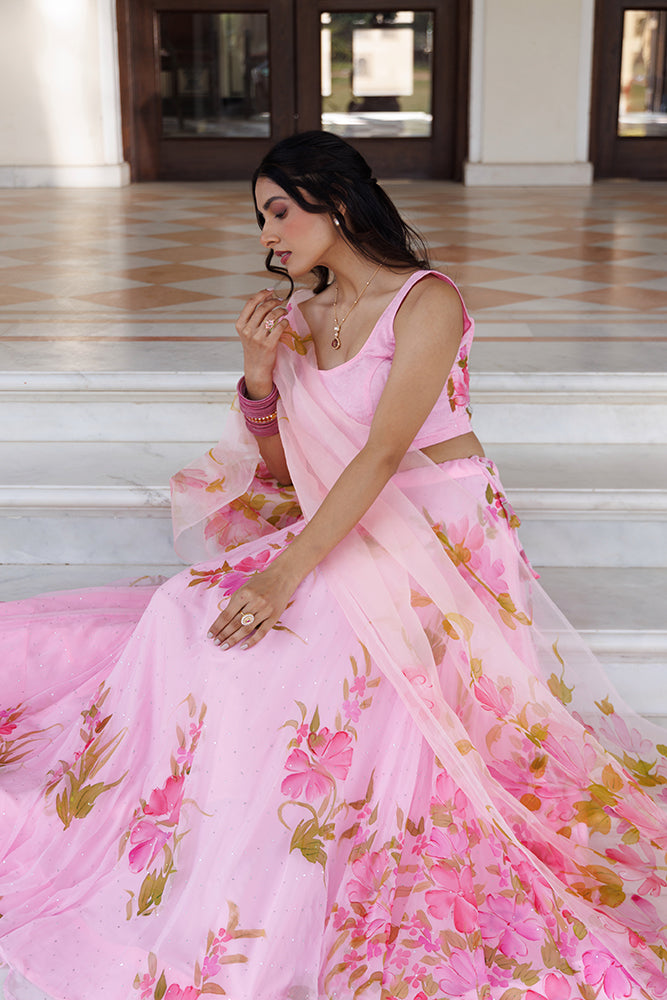Sarees have long been a symbol of grace, tradition, and craftsmanship. But in today’s fast-paced world, not all sarees are created equal. While shopping for that perfect drape, you might have come across two key terms — handloom and powerloom sarees. At first glance, they may look similar, but the difference runs deeper than the surface.
So, how can you tell which is which? And more importantly — which one should you buy? At Geroo Jaipur, where we celebrate the art of handcrafted fashion, we're here to guide you through the difference between these two weaving methods and help you make an informed, meaningful choice.
🧵 What is a Handloom Saree?
A handloom saree is woven manually on a loom operated by hand. Each piece is a labor of love, where skilled artisans bring centuries-old techniques to life. These sarees are often made in small batches, with immense attention to detail, texture, and design. The process is time-consuming — but the result? A unique, luxurious piece with soul.
Key Features of Handloom Sarees:
-
Slight irregularities or minor variations in weave — these are the marks of authenticity, not flaws.
-
Lightweight and breathable fabrics like cotton, silk, or linen.
-
Intricate borders and pallu designs created thread-by-thread.
-
Often includes techniques like jamdani, paithani, ikat, banarasi, or hand-painted embellishments — all done by hand.
⚙️ What is a Powerloom Saree?
A powerloom saree, on the other hand, is machine-made. The loom is powered by electricity, allowing for faster production and cheaper prices. Powerloom sarees can mimic the look of handwoven ones but often lack the texture, feel, and individuality of the original.
Key Features of Powerloom Sarees:
-
Uniform weave with no irregularities.
-
Mass-produced, often resulting in similar patterns across brands.
-
Usually heavier due to synthetic or blended yarns.
-
Less breathable and less sustainable in comparison to handloom.
🧐 How to Spot the Difference While Shopping
Here’s how you can tell whether a saree is handloom or powerloom — even if you're shopping online:
1. Look at the Finish
Powerloom sarees often look too perfect. If the weave is unnaturally uniform and machine-precise, it’s probably powerloom. Handloom sarees will have small, charming inconsistencies.
2. Feel the Fabric
Handloom fabrics tend to be softer and more breathable, especially in natural fibers. Powerloom sarees may feel stiffer or synthetic.
3. Check the Edges
Handloom sarees usually have “pin marks” on the selvage (edges), a result of being mounted on the loom by hand. These marks are a good indicator of authenticity.
4. Ask for the GI Tag or Handloom Mark
Authentic handloom sarees often come with a Geographical Indication (GI) tag or India Handloom Brand mark to assure buyers of their origin and craft.
💛 Why Choose Handloom?
At Geroo Jaipur, we believe in more than just selling clothing — we believe in telling stories. Our handloom sarees support rural artisans, preserve heritage weaving techniques, and promote sustainable fashion.
By choosing handloom:
-
You support artisan livelihoods and traditional craftsmanship.
-
You own a piece that’s unique and not mass-produced.
-
You contribute to a slower, more sustainable fashion industry.
Yes, handloom sarees may cost a little more — but you’re paying for artistry, time, and soul.
🛍️ Shop Mindfully with Geroo Jaipur
At Geroo Jaipur, every handcrafted saree is a work of art. Whether it’s hand-painted, hand-dyed, or woven by skilled artisans, each piece carries a story waiting to be worn. From Chanderi to Mulmul to Leheriya, our collection features sarees that are not just beautiful — they’re meaningful.
We encourage you to ask questions when you shop, read product descriptions carefully, and look for transparency. And when in doubt, reach out to us — we love helping our customers choose the perfect saree that matches both their style and values.
✨ Final Thought
In a world full of fast fashion and lookalikes, handloom sarees are a quiet rebellion — a choice to wear something rooted in culture, craftsmanship, and care. The next time you're shopping for a saree, pause for a moment. Look deeper. Ask yourself not just how it looks, but how it was made.
Because what you wear should not only make you feel beautiful — it should mean something too.






